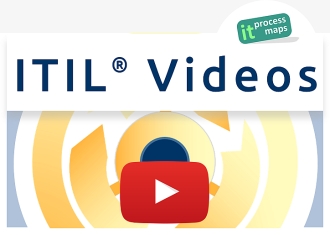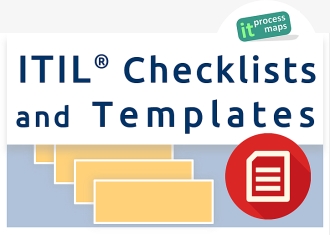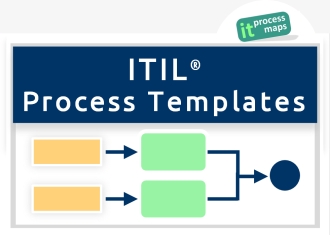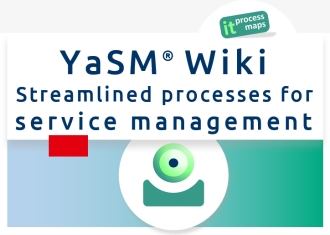ITIL 2011: Difference between revisions
No edit summary |
mNo edit summary |
||
| Line 41: | Line 41: | ||
== ITIL 2011 Processes == | == ITIL 2011 Processes == | ||
===<span id="ITIL 2011 Service | ===<span id="ITIL 2011 Service Strategy">ITIL 2007 vs. ITIL 2011: Changes in [[ITIL V3 Service Strategy|Service Strategy]]</span>=== | ||
====<span id="ITIL 2011 Service Strategy General">General</span>==== | |||
* ITIL 2011 has introduced a clearly defined set of strategic processes, including [[ITIL Strategy Management|Service Management for IT Services]] and [[Business Relationship Management]]. | |||
====<span id="ITIL 2011 Strategy Management">Strategy Management for IT Services</span>==== | |||
* [[ITIL Strategy Management|Service Management for IT Services]] has been introduced as a new process in ITIL 2011. | |||
* In the previous ITIL V3 (2007) version, strategic assessments and the development of the service strategy were performed under Service Portfolio Management. | |||
* To support the IT Steering Group the new ITIL role [[ITIL Strategy Management#Service Strategy Manager|Service Strategy Manager]] has been introduced. | |||
====<span id="ITIL 2011 Service Portfolio Management">Service Portfolio Management</span>==== | |||
* [[Service Portfolio Management]] has been re-focused to cover activities associated with managing the [[Service Portfolio Management#Service Portfolio|Service Portfolio]], following the introduction of the [[ITIL Strategy Management|Strategy Management process]] in ITIL 2011. | |||
* Strategic assessments and the development of the service strategy were removed from the process. | |||
* Added output [[Service Portfolio Management#ITIL Service Charter|Service Charter]] and [[Service Portfolio Management#ITIL Service Model|Service Model]]. | |||
====<span id="ITIL 2011 process Business Relationship Management">Business Relationship Management</span>==== | |||
* [[Business Relationship Management]] has been introduced as a new process in ITIL 2011. | |||
* The latest guidance places [[Business Relationship Management#Business Relationship Management Satisfaction|customer satisfaction surveys]] and the [[Business Relationship Management#ITIL Complaints Management|management of complaints]] as part of Business Relationship Management. As a result, the corresponding processes have been moved from Continual Service Improvement to Business Relationship Management. | |||
* The role [[Roles within ITIL V3#Business Relationship Manager|Business Relationship Manager]] has been introduced to perform the activities in the Business Relationship Management process. | |||
* Added output [[Business Relationship Management#ITIL Customer Portfolio|Customer Portfolio]] and [[Business Relationship Management#ITIL Service Outcomes|Desired Service Outcomes]]. | |||
<p> </p> | |||
===<span id="ITIL 2011 Service Design">ITIL 2007 vs. ITIL 2011: Changes in [[ITIL V3 Service Design|Service Design]]</span>=== | |||
====<span id="ITIL 2011 Service Design General">General</span>==== | |||
* In ITIL 2011 the process interfaces of '''''all Service Design processes''''' have been adapted following the introduction of Design Coordination. | |||
====<span id="ITIL 2011 process Design Coordination">Design Coordination</span>==== | ====<span id="ITIL 2011 process Design Coordination">Design Coordination</span>==== | ||
| Line 50: | Line 88: | ||
* New: The [[ITIL Design Coordination#Service Design Policy|Service Design Policy]] provides guidance on how to ensure that a consistent approach is applied to all design activity. | * New: The [[ITIL Design Coordination#Service Design Policy|Service Design Policy]] provides guidance on how to ensure that a consistent approach is applied to all design activity. | ||
====<span id="ITIL 2011 process Service Catalogue Management">Service Catalogue Management</span>==== | ====<span id="ITIL 2011 process Service Catalogue Management">Service Catalogue Management</span>==== | ||
| Line 88: | Line 124: | ||
* Added output [[IT Security Management#ITIL Security Management Rules|Event Filtering and Correlation Rules]]. | * Added output [[IT Security Management#ITIL Security Management Rules|Event Filtering and Correlation Rules]]. | ||
====<span id="ITIL 2011 Compliance">Compliance Management</span>==== | |||
* No major differences between ITIL V3 (2007) and ITIL 2011 in [[Compliance Management]]. | |||
====<span id="ITIL 2011 Architecture">Architecture Management</span>==== | |||
* No major differences between ITIL V3 (2007) and ITIL 2011 in [[IT Architecture Management|Architecture Management]]. | |||
====<span id="ITIL 2011 Supplier Management">Supplier Management</span>==== | |||
* No major differences between ITIL V3 (2007) and ITIL 2011 in [[Supplier Management]]. | |||
* All suppliers and contracts are managed within the [[Supplier Management#SCMIS|Supplier and Contract Management Information System (SCMIS)]], which in ITIL V3 was known as the "Supplier & Contract Database (SDC)". | |||
<p> </p> | <p> </p> | ||
===<span id="ITIL 2011 Service Transition"> | ===<span id="ITIL 2011 Service Transition">ITIL 2007 vs. ITIL 2011: Changes in [[ITIL V3 Service Transition|Service Transition]]</span>=== | ||
====<span id="ITIL 2011 process Change Management">Change Management</span>==== | ====<span id="ITIL 2011 process Change Management">Change Management</span>==== | ||
| Line 151: | Line 201: | ||
<p> </p> | <p> </p> | ||
===<span id="ITIL 2011 Service Operation"> | ===<span id="ITIL 2011 Service Operation">ITIL 2007 vs. ITIL 2011: Changes in [[ITIL V3 Service Operation|Service Operation]]</span>=== | ||
====<span id="ITIL 2011 process Event Management">Event Management</span>==== | ====<span id="ITIL 2011 process Event Management">Event Management</span>==== | ||
Revision as of 12:00, 8 December 2011
<seo metakeywords="itil 2011, itil 2011 edition, itil 2011 vs. itil 2007, itil 2007 vs. itil 2011, itil 2011 2007" metadescription="What is new in ITIL 2011? The main differences: ITIL 2011 processes vs. ITIL V3 processes." />

Four years after the introduction of ITIL® V3, the main guidance has been updated. This page highlights the changes and clarifications introduced with the new version ITIL 2011.
Why the new ITIL 2011 Edition?
ITIL 2011 takes into account feedback from the user and training community.
As the official ITIL Update FAQs [1] state, "ITIL 2011 is an update, not a new version". No entirely new concepts have been added, but the aim of the update is to "resolve errors and inconsistencies in the text and diagrams across the whole suite".
A new Naming Convention for ITIL Editions
As ITIL V2 is about to be phased out, the latest edition is now referred to as "ITIL 2011" or simply "ITIL", while the term "ITIL 2007" is used for the first edition of ITIL V3.
Differences between ITIL 2007 and ITIL 2011
An ITIL 2011 summary of the updates is available at the Official ITIL Website. This provides an overview of the main changes and their underlying motivations, but not a detailed account of what precisely has changed where in the books.

While no entirely new concepts have been added in ITIL 2011, at first sight it is obvious that the ITIL 2011 books are a lot thicker than the 2007 edition, so in fact a substantial amount of content has been added and it would be wrong to dismiss the modifications as merely 'cosmetical'.
There are a few new processes, while others are described in greater detail. Apart from these bigger changes, many clarifications and enhancements were introduced throughout all parts of the books on a smaller scale. As a result, it is (in our view) almost impossible to compare the two editions and come up with a detailed and complete list of all changes.
But we are able to highlight the more important differences. As we bring our ITIL Process Map and this ITIL Wiki in line with ITIL 2011, we record the modifications in a change log. We think the change log is the best information we can provide on what has changed in ITIL 2011, so we decided to publish it here as we gradually update to ITIL 2011.
ITIL 2011 Processes
ITIL 2007 vs. ITIL 2011: Changes in Service Strategy
General
- ITIL 2011 has introduced a clearly defined set of strategic processes, including Service Management for IT Services and Business Relationship Management.
Strategy Management for IT Services
- Service Management for IT Services has been introduced as a new process in ITIL 2011.
- In the previous ITIL V3 (2007) version, strategic assessments and the development of the service strategy were performed under Service Portfolio Management.
- To support the IT Steering Group the new ITIL role Service Strategy Manager has been introduced.
Service Portfolio Management
- Service Portfolio Management has been re-focused to cover activities associated with managing the Service Portfolio, following the introduction of the Strategy Management process in ITIL 2011.
- Strategic assessments and the development of the service strategy were removed from the process.
- Added output Service Charter and Service Model.
Business Relationship Management
- Business Relationship Management has been introduced as a new process in ITIL 2011.
- The latest guidance places customer satisfaction surveys and the management of complaints as part of Business Relationship Management. As a result, the corresponding processes have been moved from Continual Service Improvement to Business Relationship Management.
- The role Business Relationship Manager has been introduced to perform the activities in the Business Relationship Management process.
- Added output Customer Portfolio and Desired Service Outcomes.
ITIL 2007 vs. ITIL 2011: Changes in Service Design
General
- In ITIL 2011 the process interfaces of all Service Design processes have been adapted following the introduction of Design Coordination.
Design Coordination
- Design Coordination has been added as a new process, in line with the latest ITIL 2011 guidance.
- Design Coordination is now responsible for coordinating the design activities carried out by other Service Design processes. In the previous ITIL version, some of these tasks were carried out as part of the Service Level Management process.
- New: The Service Design Policy provides guidance on how to ensure that a consistent approach is applied to all design activity.
Service Catalogue Management
- No major differences between ITIL V3 (2007) and ITIL 2011 in Service Catalogue Management.
Service Level Management
- Service Level Management has been completely redesigned in ITIL 2011 following the introduction of the Design Coordination process. Coordinating activities have been removed.
- Service Level Management is now mainly responsible for gathering service requirements, as well as monitoring and reporting with regards to agreed service levels.
Risk Management
- No major differences between ITIL V3 (2007) and ITIL 2011 in Risk Management.
Capacity Management
- No major differences between ITIL V3 (2007) and ITIL 2011 in Capacity Management.
- Added output Event Filtering and Correlation Rules.
Availability Management
- No major differences between ITIL V3 (2007) and ITIL 2011 in Availability Management.
- Added output Event Filtering and Correlation Rules.
IT Service Continuity Management
- No major differences between ITIL V3 (2007) and ITIL 2011 in IT Service Continuity Management.
Information Security Management
- No major differences between ITIL V3 (2007) and ITIL 2011 in Information Security Management.
- Added output Event Filtering and Correlation Rules.
Compliance Management
- No major differences between ITIL V3 (2007) and ITIL 2011 in Compliance Management.
Architecture Management
- No major differences between ITIL V3 (2007) and ITIL 2011 in Architecture Management.
Supplier Management
- No major differences between ITIL V3 (2007) and ITIL 2011 in Supplier Management.
- All suppliers and contracts are managed within the Supplier and Contract Management Information System (SCMIS), which in ITIL V3 was known as the "Supplier & Contract Database (SDC)".
ITIL 2007 vs. ITIL 2011: Changes in Service Transition
Change Management
- The structure of the Change Management process has been modified to highlight that significant Changes require authorization at different points in their lifecycle.
- New sub-processes have been added to assess Change Proposals and to implement minor Changes:
- Change Management now submits major Changes to the Change Evaluation process for a formal assessment.
- Change Scheduling has been revised so that the detailed planning of a Change and the corresponding Release is performed by Release Management.
- Change Models have been given a more prominent role in Change Management, being used not only for Standard Changes (low-risk Changes on an operational level), but also for recurring significant Changes.
Change Evaluation
- A Change Evaluation process has been added, following a clarification in the ITIL books that the purpose of this process is the evaluation of major Changes.
- Change Evaluation is called upon by the Change Management process at various points in a Change’s lifecycle to perform a Change assessment.
- The results of a formal Change evaluation are documented in a Change Evaluation Report.
Project Management (Transition Planning and Support)
- Project Management (Transition Planning and Support) has been revised to highlight that its main responsibility is to coordinate the various service transition projects and resolve conflicts.
- Projects are initiated when Service Portfolio Management has chartered a new or substantially changed service.
- The Project Management process now calls upon other processes, for instance Design Coordination and Release Planning, to perform planning activities on a detailed level.
Application Development
- No major differences between ITIL 2007 and ITIL 2011 in Application Development.
Release and Deployment Management
- In ITIL 2011 Release Management is called upon from Project Management (Transition Planning and Support) to perform the detailed planning of Release build, Release test and Release deployment.
- Additional interfaces between Release Management and Project Management - Transition Planning and Support have been introduced to make sure that Project Management is constantly provided with current planning information.
- The latest ITIL 2011 guidance also specifies that Minor Changes are implemented by Change Management without the involvement of Release Management.
Service Validation and Testing
- In ITIL 2011 additional interfaces between Service Validation & Testing and Project Management have been added to make sure that Project Management is constantly provided with current planning information.
- The ITIL V3 sub-process "Service Design Validation" has been removed as this activity now takes place as part of Change Evaluation.
Service Asset and Configuration Management
- ITIL 2011 requires new interfaces in Service Asset and Configuration Management to make sure that the ITIL Project Management and Change Evaluation processes are constantly provided with current planning information.
Knowledge Management
- No major differences between ITIL 2007 and ITIL 2011 in Knowledge Management.
ITIL 2007 vs. ITIL 2011: Changes in Service Operation
Event Management
- Event Management has been updated to reflect the concept of 1st Level Correlation and 2nd Level Correlation.
- The process flows have been updated to reflect the more detailed guidance in the ITIL 2011 books.
Incident Management
- Guidance has been improved in Incident Management on how to prioritize an Incident, including the addition of a new checklist Incident Prioritization Guideline.
- Additional steps have been added to Incident Resolution by 1st Level Support to explain that Incidents should be matched (if possible) to existing Problems and Known Errors.
- Incident Resolution by 1st Level Support and Incident Resolution by 2nd Level Support have been considerably expanded to provide clearer guidance on when to invoke Problem Management from Incident Management. The emphasis is now on restoring services as quickly as possible, and to seek the help of Problem Management if the underlying cause of an Incident cannot be resolved with a minor Change and/or within the committed resolution time.
- Incident Closure and Evaluation now states more clearly that it is important to check whether there are new Problems, Workarounds or Known Errors that must be submitted to Problem Management.
Request Fulfilment
- The Request Fulfilment process has been completely revised to reflect the latest guidance. Request Fulfilment now consists of five sub-processes, to provide a detailed description of all activities and decision points.
- Request Fulfilment now contains interfaces with Incident Management (if a Service Request turns out to be an Incident) and Service Transition (if fulfilling of a Service Request requires the involvement of Change Management).
- A clearer explanation of the information that describes a Service Request and its life cycle has been added.
- The concept of Service Request Models is explained in more detail.
Access Management
- An interface between Access Management and Event Management has been added, to emphasize that (some) Event filtering and correlation rules should be designed by Access Management to support the detection of unauthorized access to services.
- A dedicated activity has been added to revoke access rights if required, to make this point clearer.
- It has been made clearer in the Request Fulfilment and Incident Management processes that the requester’s authorization must be checked.
Problem Management
- A new sub-process Proactive Problem Identification has been added to emphasize the importance of proactive Problem Management.
- In Problem Categorization and Prioritization, it has been made clearer that categorization and prioritization should be harmonized with the approach used in Incident Management, to facilitate matching between Incidents and Problems.
- The concept of recreating Problems during Problem Diagnosis and Resolution is now more prominent.
- Problem Diagnosis and Resolution has been completely revised to provide clearer guidance on how this process cooperates with Incident Management.
- The new ITIL 2011 books contain an expanded section on problem analysis techniques and examples for situations where the various techniques may be applied.
IT Operations Control
- No major differences between ITIL 2007 and ITIL 2011 in IT Operations Control.
Facilities Management
- No major differences between ITIL 2007 and ITIL 2011 in Facilities Management.
Application Management
- Application Management is treated in ITIL as a "function". It plays an important role in the management of applications and systems.
- Not all Application Management activities are covered by other ITIL processes - which is why at IT Process Maps we decided to introduce an Application Management process.
Technical Management
- Technical Management - treated in ITIL as a "function" - plays an important role in the management of the IT infrastructure.
- Not all Technical Management activities are covered by other ITIL processes, so at IT Process Maps we decided to introduce a specific Technical Management process.






